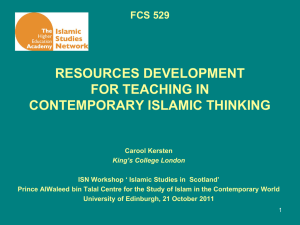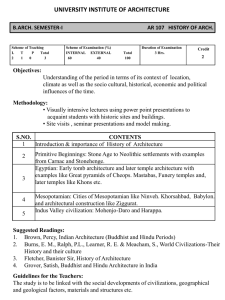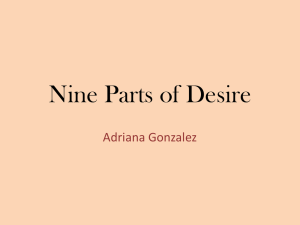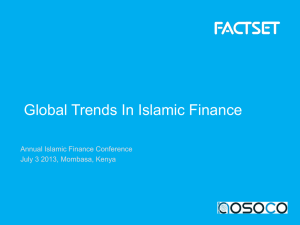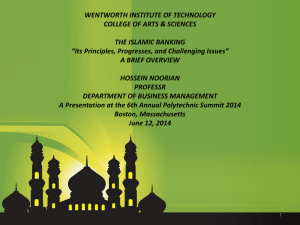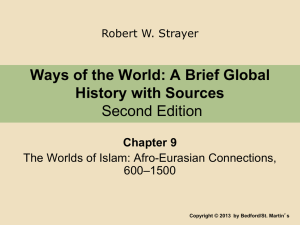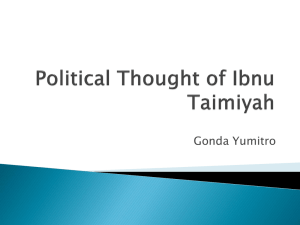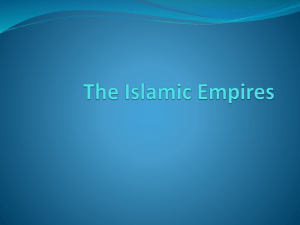Topic 3: History of Islamic Economic Thought
advertisement
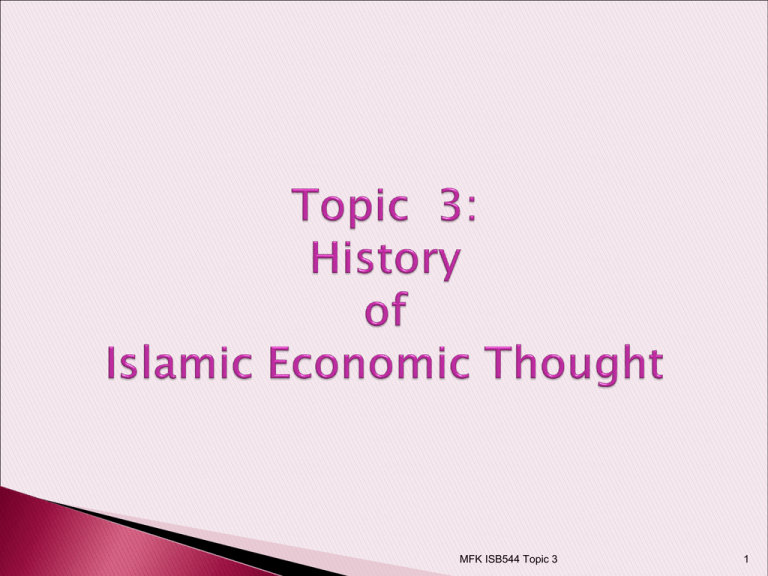
MFK ISB544 Topic 3 1 i. ii. iii. iv. Quranic and Sunnatic perspectives on economics. Contribution of eminent jurists, philosophers, Sufis etc. Contemporary Islamic Economic Thought. Historical Development and Islamic economic reform in Malaysia. MFK ISB544 Topic 3 2 MFK ISB544 Topic 3 3 At the end of the lessons, students should be able: To highlight the contribution of eminent jurist towards Islamic economics. MFK ISB544 Topic 3 4 Foundations (450H/1058 CE) •Discussion focus on ‘what is’ ( i.e. description of the economic phenomena) •Working on just behavior and sound policy and defining the limits of permissibility in the conduct of worldly affairs Second Phase (450-850H/1058-1446 CE) •Started with a rich intellectual heritage •Faced with political reality characterised by the disintegration of the central Abbasid •Corruption at high places and moral decline at the community level Third Phase (850-1350H/1446-1932 CE) •The decline in independent thinking has already yielded to stagnation •But there is a fresh stirring during the last two hundred years in which a number of thinkers and reformers called for a return to the Quran and Sunnah for inspiration and guidance •An age of prosperity •The realm of Islam extended from Morocco and Spain in the west to India in the east, each region having numerous centres of intellectual activity MFK ISB544 Topic 3 5 Contribution of eminent jurists, philosophers, Sufis etc Foundations (450H/1058CE) Second Phases Third Phase (450H -850H/1058-1446 CE) (850-1350H/1446-1932 CE) Abu Yusuf Al-Ghazalli Shah Waliullah Muhamad Bin al-Hassan Ibn Taymiyyah Mohd Iqbal Abu Ubaid Ibn Khaldun Harith bin Asad al Muhasibi Junaid Baghdadi Mawardi Ibn Miskawaih MFK ISB544 Topic 3 6 MFK ISB544 Topic 3 7 At the end of the lessons, students should be able: To describe the contemporary Islamic economic thought. MFK ISB544 Topic 3 8 Need to be emphasis that Islamic economic has its own identity. IE is not something new, it has emerge since the reveal of wahyu to Prophet Muhammad (PBUH). Hence, the principle of IE has been in existence earlier than the western economic paradigm. MFK ISB544 Topic 3 9 Islam, as a deen, outlines principles and doctrines to guide relationship among human being and the Allah Almighty. Unlike Judaism and Christianity which regard as a specific religion, Islam through Shari’ah has provide human being a comprehensive guideline in dealing with material and spiritual matters. MFK ISB544 Topic 3 10 Islamic resurgence which began in 1930s motivate Muslim economists worldwide to re-develop economics disciplines that in line with Islamic teaching. The momentum of Islamic resurgence is at its height in 70s,80s and continue until today. Islamic resurgence also contributed to the end of the colonial era in 1960s. As the original native of the land has full control on the management of economy, greater attention on was given to the Islamic injunctions relevant to economics. MFK ISB544 Topic 3 11 As such, review on the modern institutions such as banking, insurance, joint stock companies, stock exchange and taxation has been conducted. Those institutions that could not be legitimize on Shari’ah grounds, necessitated a search for alternatives which lead to a number of works to attend to the broader issues involved. As a result, subject such as the nature of economic enterprise, ownership, organization of production and economic development were discussed in some detail. MFK ISB544 Topic 3 12 In addition, greater details attention was dedicated on public finance, social security, industrial relations and banking without interest. Subsequently, the resurgence of Islam lead to the First International Conference on Islamic Economics held at Makkah Mukarramah in February 1976 – which regarded as a starting point for the establishment of Islamic economic thought. Simultaneously it provided a great “political will” in establishing Islamic financial institutions i.e. Islamic Development Bank in Jeddah and the Dubai Islamic Bank. MFK ISB544 Topic 3 13 Currently, we have more than ____ Islamic financial institutions as well as three countries, Pakistan, Sudan and Iran, have switched to interest-free banking at the national level. The emergence and continuation of the Islamic financial movement has produced a lot of economic and juridicial research relating to its operational details. More important, however, are the recent attempts to capture a vision of the Islamic economic system as a whole within the framework of conventional macro – economic analysis. MFK ISB544 Topic 3 14 Nonetheless, literature on IE thought, according to Anas Zarqa, can be classified into three areas:i. General comparison of Islamic economic with other world economic system i.e. Capitalism and Socialism. ii. Critiques on other world economic system. iii. Discussion on specific economic issues such as riba, zakat, Islamic financial system and etc. MFK ISB544 Topic 3 15 In the early days of Islamic economics resurgence, most of the literature focus on issues of riba, roles of zakat institutions and Islamic financial system. In fact, until recently these areas remain as a focal point in discussing Islamic economic – perhaps it lies on the fact that Islamic banking and finance is a stepping stone to re-emulate Islamic economics system. MFK ISB544 Topic 3 16 As a result, not much emphasis was given to other aspects of economics especially in the area that required comprehensive critical analysis on conventional economics concepts. However, M.A Mannan (1970) and Monzer Kahf (1978) were among the Muslim economists that has significantly wrote on Islamic perspective on conventional economics concepts. MFK ISB544 Topic 3 17 In fact in Islamic economics thought, they were regards as a pioneer in the area of microeconomics. Apart from that, a number of works on the microeconomics has been edited by:i. Khurshid Ahmad(1980), ii. Rafiqul Islam Molla (1988), iii. Ausaf Ahmad and Kazim Raza Awan (1992) and iv. Sayyid Tahir (1992) MFK ISB544 Topic 3 18 As a result, not much emphasis was given to other aspects of economics especially in the area that required comprehensive critical analysis on conventional economics concepts. However, M.A Mannan (1970) and Monzer Kahf (1978) were among the Muslim economists that has significantly wrote on Islamic perspective on conventional economics concepts. MFK ISB544 Topic 3 19 MFK ISB544 Topic 3 20 At the end of the lessons, students should be able: To explain historical development and Islamic economic reforms that has been taken place in Malaysia. MFK ISB544 Topic 3 21 In Malaysia, efforts to re-emulate Islamic economics has been pioneered by university’s lecturer in the related field through:- i. Seminars. ii. Colloquium. iii. conferences and etc. MFK ISB544 Topic 3 22 Among the courses organised are as follows:- Date Course Organised by July-December, 1986 Short Course on Islamic Economics Kulliyah of Economics and Management Sciences of IIUM 14-18 July 1987 Course on Islamic Economics The then School of Business Management of ITM 16-18 November 1989 Course on Islamic Economics: Philosophy and Application School of Economy and Public Administration of UUM MFK ISB544 Topic 3 23 Subsequently, Islamic Economics course has been taught to undergraduates as well as post-graduate students in Malaysia’s public universities. Apart from that, some of Islamic economics aspects has been incorporated in syllabus of economics that taught to form 4 and form 5 students in secondary school. MFK ISB544 Topic 3 24 Islamic economic reforms in Malaysia began in 1981 when Tun Dr. Mahathir Mohamad came to power. Among the initiative taken by him were:- Initiative Description Setting up of Islamic Consultative Body (ICB) •To ensure that no development plans and policies ran against ‘Islamic values’ •Made up of Islamic experts in administration, law, economic, medicine, engineering, agriculture, sociology, Islamic philosophy and politics •It looks as if the Mahathir Administration was attempting to sift development policies using some kind of Islamic filter and to “Islamize’ policies or aspects of policies not in line with Islam Inculcation of Islamic values (IIV) Policy To instill ‘universal Islamic values’ to enable the country to have an effective, strong, just, and progressive administration that would help create ‘a dynamic work ethic which would increase 25 productivity’ Initiative Year Description Establishment of Islamic institutions 1983 •Bank Islam Malaysia Berhad (BIMB) •Established International Islamic University Malaysia and started taking in students to read for degrees in economic and law 1984 •YAPEIM 1985 Syarikat Takaful Malaysia Berhad 80’s •Restructuring of the institution of bayt al-mal and collection of zakat •Islamic finance companies being set up 90’s •International Offshore Financial Centre was planned for Labuan- had an aim of creating an ‘Islamic niche’ and becoming a financial centre for the region •Commercial banks set ‘Islamic window” 2000 •Commercial banks set up Islamic subsidiary •Issued license to foreign Islamic bank •Introduction of ‘Islam Hadhari’ 26 Other than that, many legal reform were also presented and passed in parliament to enable the Islamic institutions to exist and conduct their business according to Islamic requirements such as:- i. Islamic Banking Act 1983 ii. Takaful Act 1984 MFK ISB544 Topic 3 27 i. Islamic economic thought: Foundations, evaluation and needed direction, Muhammad Nejatullah Siddiqi. MFK ISB544 Topic 3 28 i. ii. iii. iv. Quranic and Sunnatic perspectives on economics. Contribution of eminent jurists, philosophers, Sufis etc. Contemporary Islamic Economic Thought. Historical Development and Islamic economic reforms in Malaysia. MFK ISB544 Topic 3 29 Read methodology and significance of Islamic economics. MFK ISB544 Topic 3 30 THANK YOU… MFK ISB544 Topic 3 31
